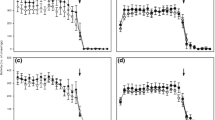Abstract
The hypothesis of dominant/territorial aggression on isolation-induced aggression was examined by comparing the behavior of isolated mice with that of familiar dominant mice. Familiar dominant mice showed as much aggression in an already known neutral space as the isolated mice. The behavioral sequences of aggression in the 2 groups showed both differences and similarities between each other. There was more variance in the aggressive behavior of the dominant mice. The differences were considered to be due to the effect of isolated housing, and the similarities were considered to be the change due to the occurrence of aggression. It is suggested that the isolated mice had a unique behavioral pattern.
Similar content being viewed by others
References
Anderson, P.K. 1961 Density, social structure, and nonsocial environment in house-mouse populations and the implications for regulation of numbers.Trans. N. Y. Acad. Sci. (2) 23: 447–451.
Anton, A.H., R.P. Schwartz & S. Kramer 1968 Catecholamines and behavior in isolated and grouped mice.J. Psychiat. Res. 6: 211–220.
Baer, H. 1971 Long-term isolation stress and its effects on drug response in rodents.Lab. Anim. Sci. 21 (3): 341–349.
Benton, D., J.F. Goldsmith, L. Gamal-El-Din, P.F. Brain & F.H. Hucklebridge 1978 Adrenal activity in isolated mice and mice of different social status.Physio. Behav. 20: 459–464.
Berry, R.J. & F.H. Bronson 1992 Life history and bioeconomy of the house mouse.Biol. Rev. 67: 519–550.
Brain, P. 1975 What does individual housing mean to a mouse?Life Sciences 16: 187–200.
Cairns, R.B. & J.S. Nakelski 1971 On fighting in mice: ontogenetic and experiential determinants.J. Comp. Physiol. Psychol. 74 (3): 354–364.
Cairns, R.B. & S.D. Scholz 1973 Fighting in mice: dyadic escalation and what is learned.J. Comp. Physiol. Psychol. 85 (3): 540–550.
Chance, M.R.A. 1962 An interpretation of some agonistic postures; the role of “cut-off” acts and postures.Symposium No.8, Zoo. Soc. Lond.: 71–89.
Crawley, J.N., W.M. Schleidt & J.F. Contrera 1975 Does social environment decrease propensity to fight in male mice?Behav. Biol. 15: 73–83.
Ely, D.L. & J.P. Henry 1974 Effects of prolonged social deprivation on murine behavior patterns, blood pressure, and adrenal weight.J. Comp. Physio. Psychol. 87 (4): 733–740.
Goldsmith, J.F., P.F. Brain & D. Benton 1976 Effects of age at differential housing and the duration of individual housing/grouping on intermale fighting behavior and adrenocortical activity in TO strain mice.Aggres. Behav. 2: 307–323.
Goldsmith, J.F., P.F. Brain & D. Benton 1978 Effects of the duration of individual or group housing on behavioural and adrenocortical reactivity in male mice.Physiol. Behav. 21: 757–760.
Ikeda, H. 1971 Methodology in the behavioral science. Tokyo Univ. Press, Tokyo )in Japanese)
Kahn, M.W. 1954 Infantile experience and mature aggressive behavior of mice: some maternal influences.J. Genet. Psychol. 84: 65–75.
King, J.A. 1957 Relationships between early social experience and adult aggressive behavior in inbred mice.J. Genet. Psychol. 90: 151–166.
Koyama, S. 1985 The effects of social deprivation on the social behavior of mice (Mus musculus).Ann. Anim. Psychol. 35 (2): 79–90. (in Japanese with English abstract)
Koyama, S. 1993 Isolation effect in mice (Mus musculus): (i) does it really induce aggression?J. Ethol. 11: 117–130.
Mackintosh, J.H. 1981 Behaviour of the house mouse. In: R.J. Berry (ed)Biology of the house mouse. The Zoological Society of London, Academic Press.
Mainardi, D., M. Mainardi, S. Parmigiani & A. Pasquali 1977 Relationship between aggressiveness due to isolation and social status in the house mouse.Accademia Nazionale Dei Lincei, Serie VIII, Vol. LXIII: 120–125.
Ota, K. 1964 Territoriality and social hierarchy.Seiri Seitai, 12–1/2: 291–299. (in Japanese with English abstract)
Parmigiani, S., D. Mainardi & A. Pasquali 1981 A comparison of aggressiveness in dominant, subordinate and isolated house mice. In: P.F. brain & D. Benton (eds.)The biology of aggression. Sythoff & Noordhoff, Netherlands.
Ramirez, J.M., T. Nakaya & Y Habu 1980 Physiological models for several types of aggression.Japanese Psychol. Rev. 23 (2): 183–207. (in Japanese with English abstract)
Toates, F. 1980 Animal behaviour. A systems approach. John Wiley & Sons Ltd.
Schwartz, R., A.M. Sackler & A.S. Weltman 1974 Adrenal relationships to aggressiveness in isolated female mice.Experientia 30: 199–200.
Valzelli, L. 1973 The “isolation syndrome” in mice.Psychopharmacologia (Berl.) 31: 305–320.
Weltman, A.S., A.M. Sackler, R. Schwartz & H. Owens 1968 Effects of isolation stress on female albino mice.Lab. Anim. Care 18 (4): 426–435.
Author information
Authors and Affiliations
About this article
Cite this article
Koyama, S. Isolation effect in mice (Mus musculus): (ii) Variance in aggression. J. Ethol. 11, 131–140 (1993). https://doi.org/10.1007/BF02350046
Received:
Accepted:
Issue Date:
DOI: https://doi.org/10.1007/BF02350046




